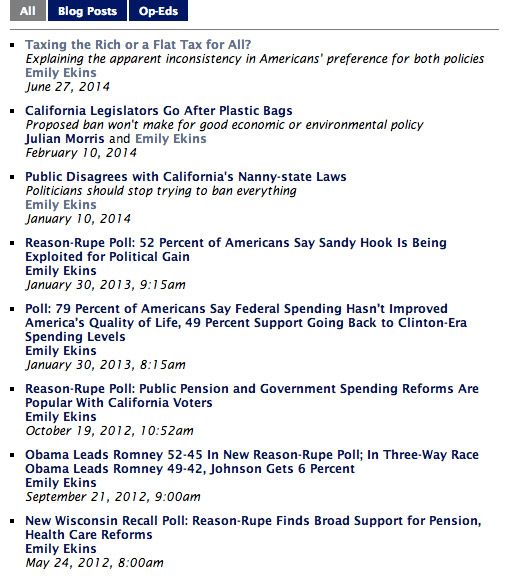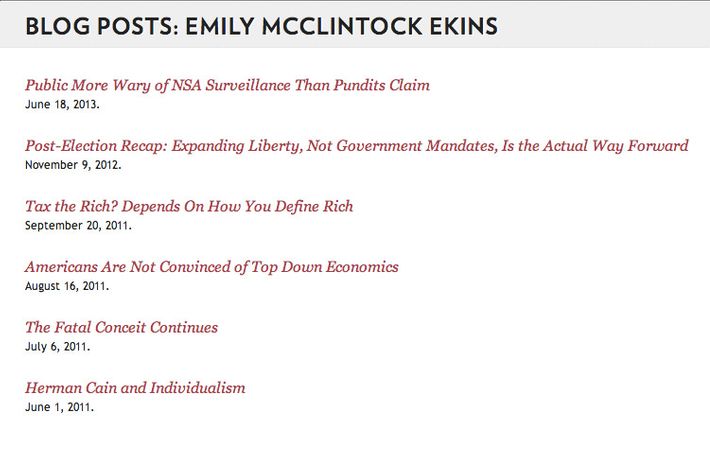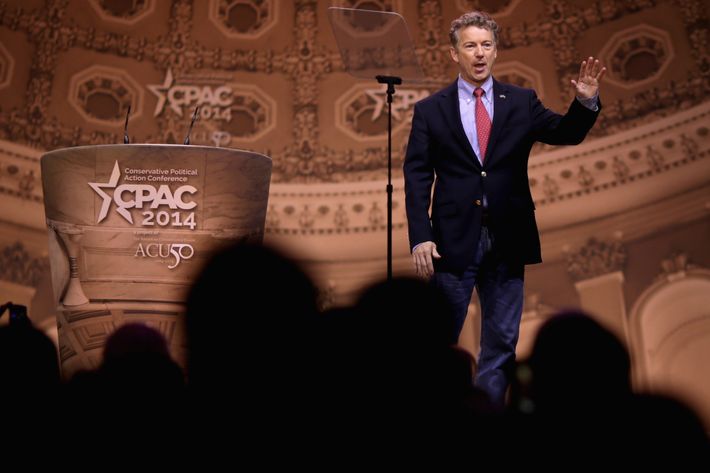
The premise underpinning Robert Draper’s New York Times Magazine cover story on the “Libertarian Moment” is that libertarians offer the cure for the Republican Party’s political difficulties. The story has lots of problems — a failure to account for recent history, in which the GOP already moved toward libertarianism after 2008, and is now moving back, not to mention a general credulousness toward its subjects — but the central problem is that its major thesis is rooted in a complete misuse of public-opinion data. I criticized Draper’s misuse of data last week. Draper and his primary source have both replied, and their replies show that the article’s erroneous conclusions turn out to be even worse than I initially described.
Draper’s analysis hinges on the premise that young voters harbor “libertarian leanings.” He offers two data points to support this, both fallacious. The first is that “fully half of voters between ages 18 and 29 are unwedded to either party.” There has been a long-term generational rise in people describing themselves in polls as independents rather than as Democrats or Republicans. But this has not caused more actual independent voting. Indeed, the rise of independent identifiers has coincided with rising polarization and a decline in swing voting. Both experimental evidence and actual voting behavior show that the majority of self-identified “independents” support one party or the other as reflexively as self-identified partisans.
When I pointed out this phenomenon, which is by now well known among political professionals, Draper merely shrugged it off in a way (“point was, they don’t consider themselves D’s”) that misses the point. What young voters “consider” themselves doesn’t matter. What matters is how they vote.
Draper’s second piece of evidence is a quote from Emily Ekins, a pollster for the Reason Foundation, who asserts, “Unlike with previous generations, we’re seeing a newer dimension emerge where they agree with Democrats on social issues, and on economic issues lean more to the right.”
This is a very strange statement. Reliable polling on the policy views of different age cohorts is hard to come by because it requires larger sample sizes and more extensive questioning than most news organizations are willing to pay for. The gold standard of generational-policy polling is the Pew Research Center, which conducts massive, detailed surveys with generational breakdowns. Pew’s findings are unambiguous. Voters under 30 have much, much more liberal views on economics than older voters do. When asked if the government has a responsibility to provide health insurance to all, they say yes, while every other generation says no. When asked if they prefer a smaller government with fewer services or a bigger government with more services, older cohorts all prefer smaller government, by margins ranging from 6 points (Generation X) to 42 points (the Silent Generation). Only millennial voters prefer bigger government — by a 15-point margin.
Draper’s story does not mention Pew’s findings. Instead he relies on a poll conducted by Reason, the libertarian magazine whose worldview is treated sympathetically throughout the story. In my story, I described Reason’s polling as “advocacy polling.” This description provoked a response by Emily Ekins, Reason’s pollster. In a series of tweets, Draper defends Reason’s polling as similar to Pew’s work, or even deeper, though he does not explain how it arrived at such divergent results.
When I wrote that Ekins does advocacy polling, I did not mean that she is incompetent, dishonest, or reporting inaccurate numbers. Advocacy polling is an honorable profession with perfectly well-qualified polling professionals. I have no reason to doubt Ekins’s credentials.
Still, it is important to understand the job of an advocacy pollster. The most important fact about polling is that, since most people’s political opinions are inconsistent and malleable, responses can vary wildly with even slight changes to the wording of a question, or even to the order of questions. Advocacy groups commission polls that, using what is often very neutral-sounding language, invariably produce results that present public opinion in a favorable light for their sponsor. There are right-wing, left-wing, and centrist versions of these kinds of polls. They exist as a publicity device to show that their sponsors’ agenda is popular.
And Ekins’s work, both for Reason and for the Cato Institute, is mostly, though not exclusively, concerned with presenting public opinion in a libertarian-positive way. You can take, as a representative example, her recap of the 2012 election, which argued, shakily, that Democrats’ social liberalism, not their populist economic message, accounted for their success. The same theme runs through much of her other work:


In her reply, Ekins points out that several of the questions in Reason’s poll of millennials, which is the basis for her quote, yield liberal responses. Young voters, the poll found, favor a living wage, higher taxes on the rich, more spending on infrastructure and job training, and so on. “Does this read like the outcome of a libertarian advocacy poll?,” she asks. Certainly not. Indeed, one might wonder why, given those findings, Ekins could hold it up as evidence that millennial voters lean to the right on economics.
The reason she claimed that is no doubt that this is the aspect of the poll that Reason trumpeted in its headline, “Millennials Think Government Is Inefficient, Abuses Its Power, and Supports Cronyism,” and the many opinion pieces trumpeting the Good News it heralds for the libertarian movement.
And Reason’s poll does yield many findings that align millennials more closely with right-wing economic thought than with left-wing economic thought. It does so through the use of crafted language. As noted above, Pew’s poll asks a basic smaller-government-fewer-services/bigger-government-more-services question, finding millennial voters far to the left of older segments of the electorate. Reason asks the same question. But it also asks another version of this question, where respondents are asked if they want bigger government with high taxes or smaller government with low taxes. As often happens in polling, the change in wording produces a dramatically different answer, increasing the small-government share from 43 percent to 57 percent.
What does this tell us? It tells us that loading one more argument onto the anti-government side predictably changes the result. Perhaps it tells us that taxes are an especially effective way for anti-government politicians to frame their public appeals. Other questions in the poll that produce conservative majorities work the same way (i.e., “If you had to choose, would you rather live in a society where the gap between rich and poor is small regardless of achievement, or a society where wealth is distributed according to one’s achievement?”).
All these questions tell us that there are ways to frame some questions so that a majority of millenial voters will furnish conservative answers. They don’t tell us that millennials have right-of-center views.

The dead giveaway is that Reason’s poll of millennials does not survey other age cohorts. There is nothing to compare the results against. Would the same questions yield even more conservative replies from older voters? Almost certainly. But such information would fatally undercut the purpose of the survey, which was to produce findings that would allow Reason and its libertarian allies to claim that young voters are social liberals but economic conservatives.
Some of the questions find that millennials are right of center within a rhetorical frame constructed by Reason. They do not show that they are right of center within the American electorate. The fact that Draper considers Reason’s poll to have the same methodology as Pew’s, when Pew’s poll compares the responses of different age cohorts and Reason’s does not, betrays a failure to understand the difference between advocacy polling and straight polling.
Draper’s story presents the self-presentation of such figures as Nick Gillespie, Rand Paul, the Competitive Enterprise Institute, and other libertarians almost entirely at face value. That’s his judgment call to make. But the glue that holds the story together is the factual claim that younger voters lean libertarian. That claim is simply false.






























